VOLVO 240 1990 Owner's Manual
Manufacturer: VOLVO, Model Year: 1990, Model line: 240, Model: VOLVO 240 1990Pages: 143, PDF Size: 2.32 MB
Page 21 of 143
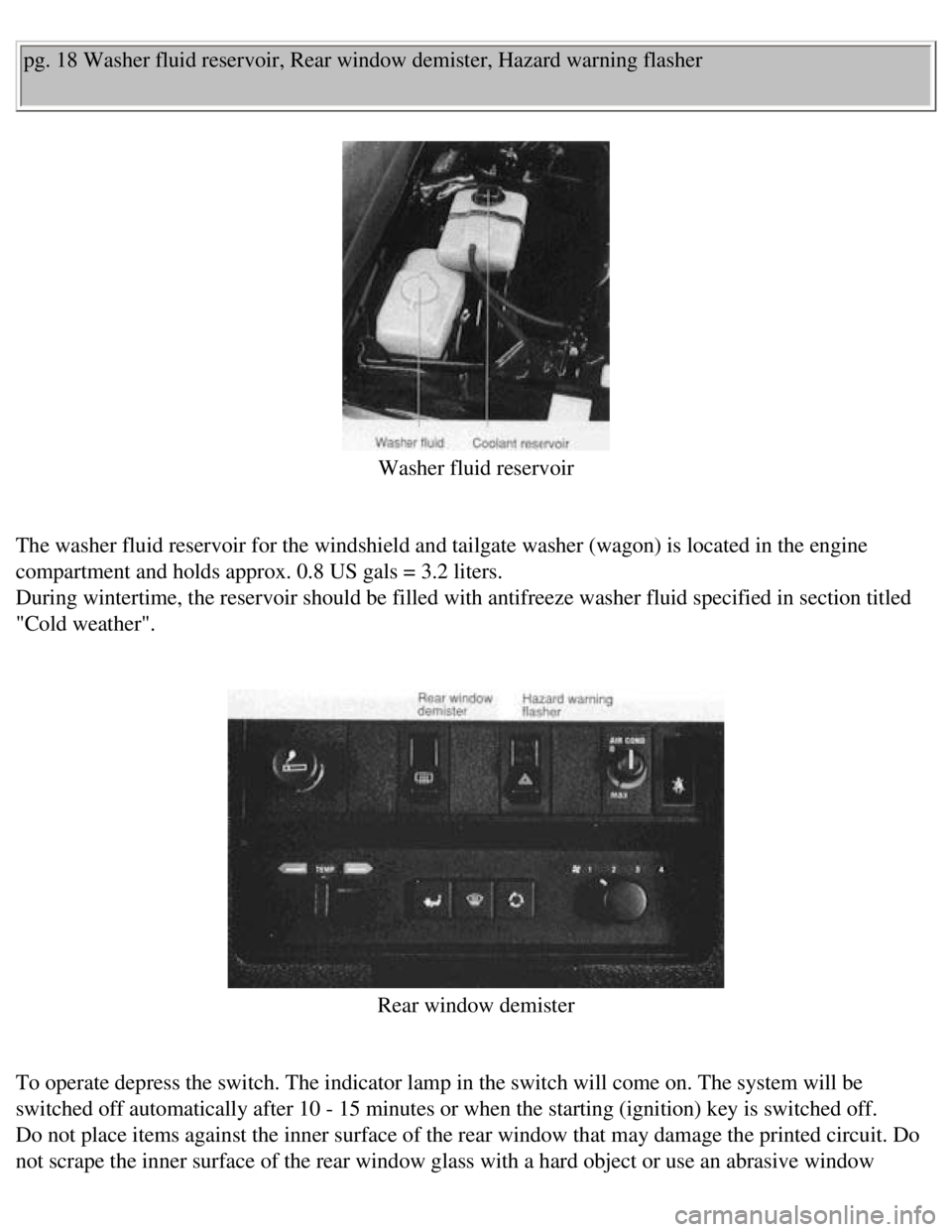
Volvo 1990 240 Model
pg. 18 Washer fluid reservoir, Rear window demister, Hazard warning flas\
her
Washer fluid reservoir
The washer fluid reservoir for the windshield and tailgate washer (wago\
n) is located in the engine
compartment and holds approx. 0.8 US gals = 3.2 liters.
During wintertime, the reservoir should be filled with antifreeze washer\
fluid specified in section titled
"Cold weather".
Rear window demister
To operate depress the switch. The indicator lamp in the switch will com\
e on. The system will be
switched off automatically after 10 - 15 minutes or when the starting (\
ignition) key is switched off.
Do not place items against the inner surface of the rear window that may\
damage the printed circuit. Do
not scrape the inner surface of the rear window glass with a hard object\
or use an abrasive window
file:///K|/ownersdocs/1990/1990_240/90240_04.htm (1 of 5)12/30/2006 8:\
25:02 AM
Page 22 of 143
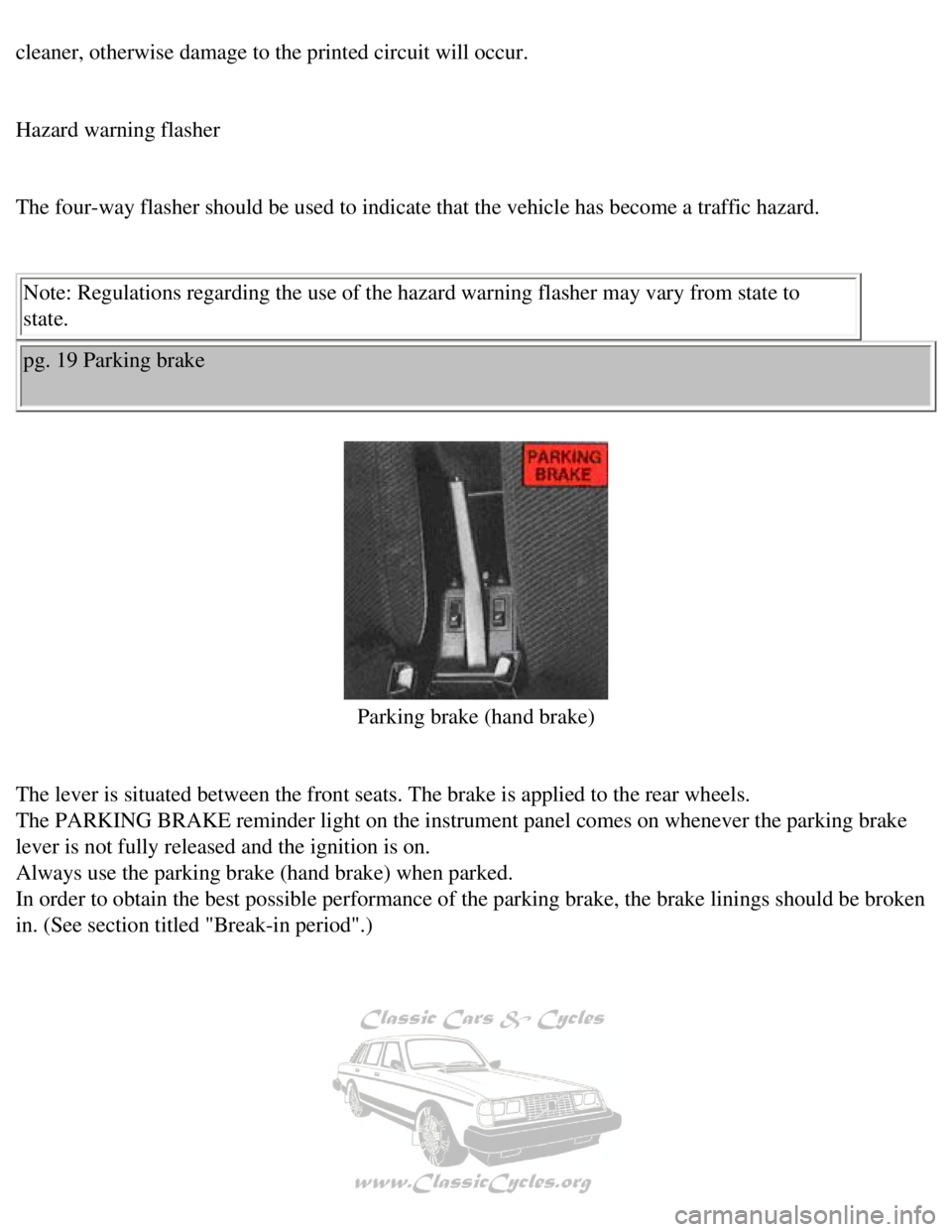
Volvo 1990 240 Model
cleaner, otherwise damage to the printed circuit will occur.
Hazard warning flasher
The four-way flasher should be used to indicate that the vehicle has bec\
ome a traffic hazard.
Note: Regulations regarding the use of the hazard warning flasher may va\
ry from state to
state.
pg. 19 Parking brake
Parking brake (hand brake)
The lever is situated between the front seats. The brake is applied to t\
he rear wheels.
The PARKING BRAKE reminder light on the instrument panel comes on whenev\
er the parking brake
lever is not fully released and the ignition is on.
Always use the parking brake (hand brake) when parked.
In order to obtain the best possible performance of the parking brake, t\
he brake linings should be broken
in. (See section titled "Break-in period".)
file:///K|/ownersdocs/1990/1990_240/90240_04.htm (2 of 5)12/30/2006 8:\
25:02 AM
Page 23 of 143
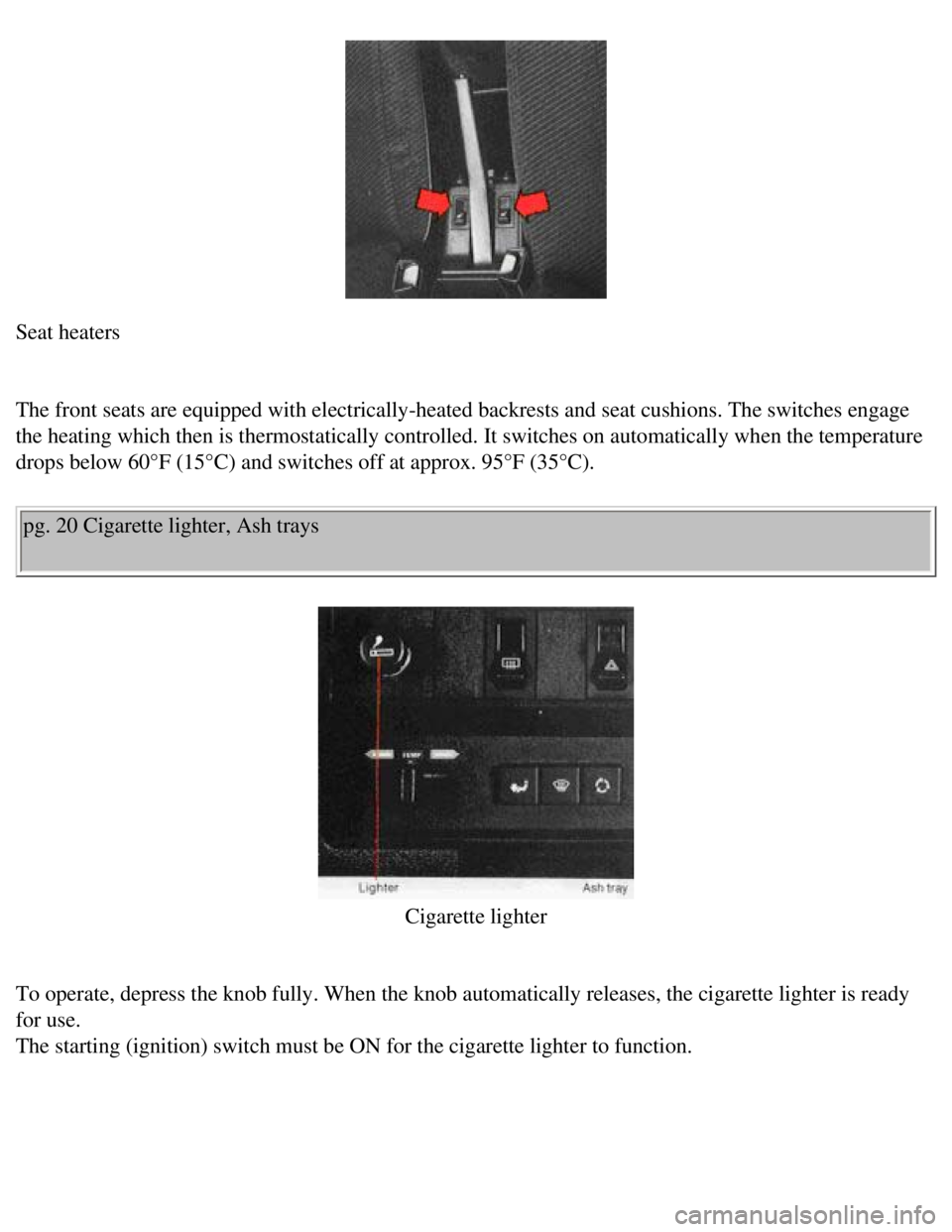
Volvo 1990 240 Model
Seat heaters
The front seats are equipped with electrically-heated backrests and seat\
cushions. The switches engage
the heating which then is thermostatically controlled. It switches on au\
tomatically when the temperature
drops below 60°F (15°C) and switches off at approx. 95°F (35\
°C). pg. 20 Cigarette lighter, Ash trays
Cigarette lighter
To operate, depress the knob fully. When the knob automatically releases\
, the cigarette lighter is ready
for use.
The starting (ignition) switch must be ON for the cigarette lighter to\
function.
file:///K|/ownersdocs/1990/1990_240/90240_04.htm (3 of 5)12/30/2006 8:\
25:02 AM
Page 24 of 143
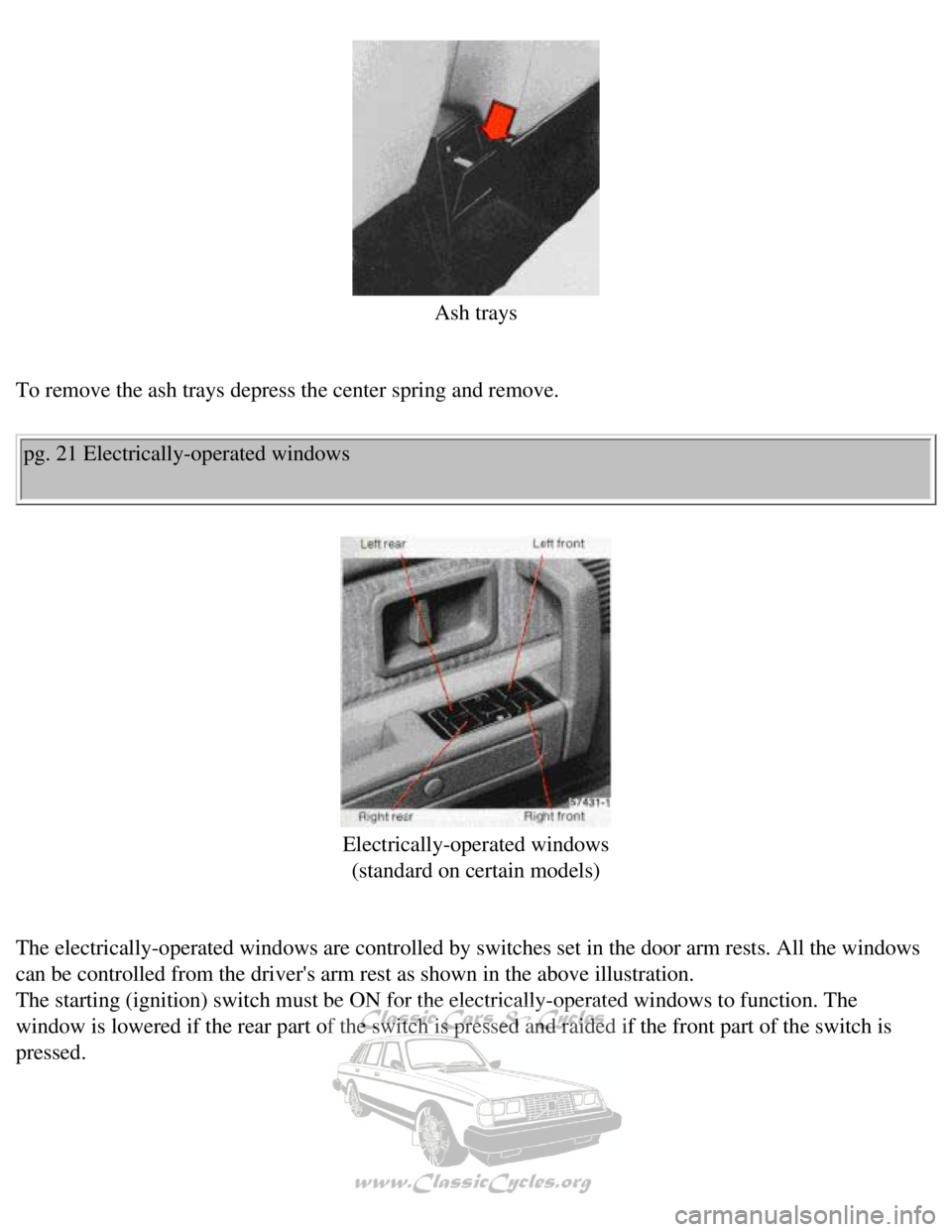
Volvo 1990 240 Model
Ash trays
To remove the ash trays depress the center spring and remove.
pg. 21 Electrically-operated windows
Electrically-operated windows
(standard on certain models)
The electrically-operated windows are controlled by switches set in the \
door arm rests. All the windows
can be controlled from the driver's arm rest as shown in the above illus\
tration.
The starting (ignition) switch must be ON for the electrically-operate\
d windows to function. The
window is lowered if the rear part of the switch is pressed and raided i\
f the front part of the switch is
pressed.
file:///K|/ownersdocs/1990/1990_240/90240_04.htm (4 of 5)12/30/2006 8:\
25:02 AM
Page 25 of 143
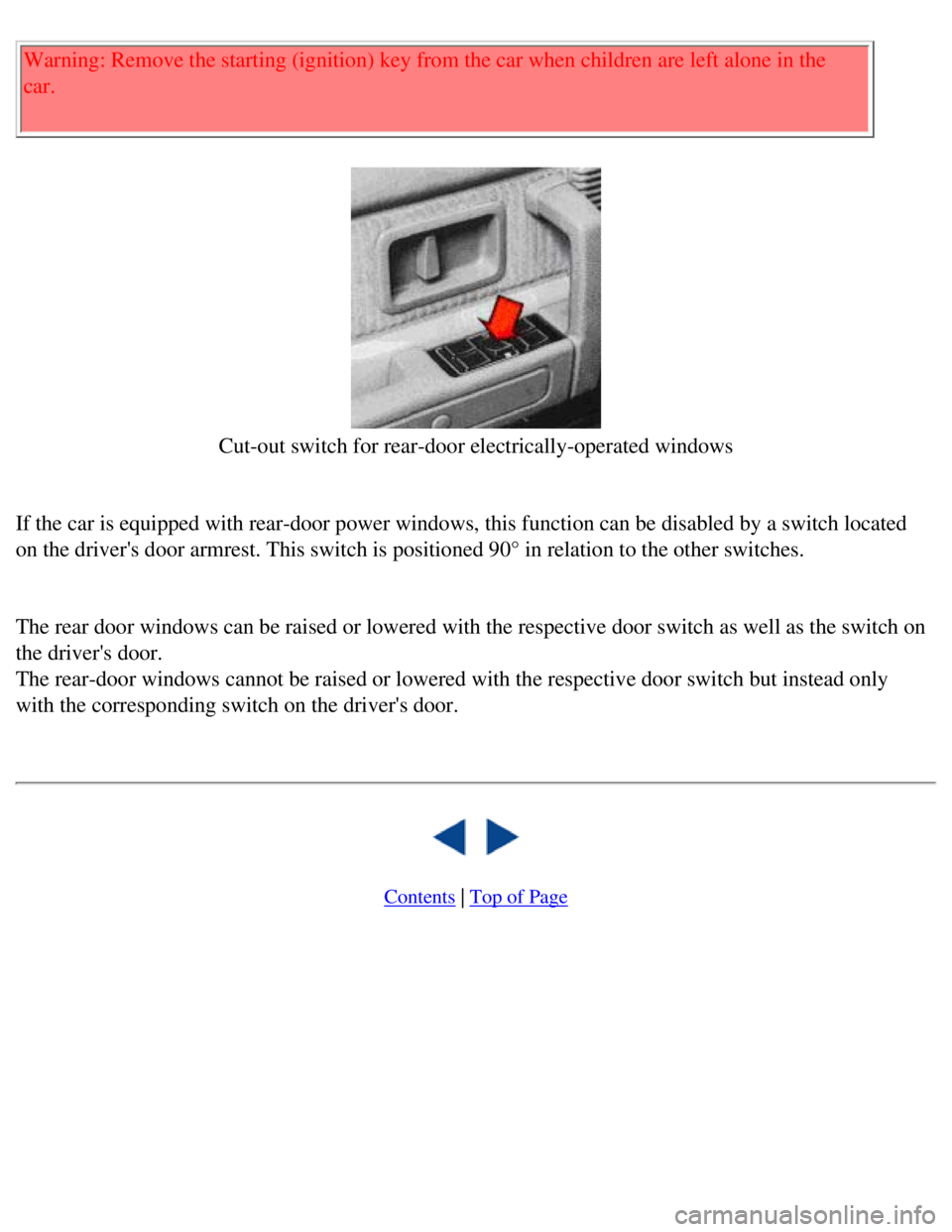
Volvo 1990 240 Model
Warning: Remove the starting (ignition) key from the car when children\
are left alone in the
car.
Cut-out switch for rear-door electrically-operated windows
If the car is equipped with rear-door power windows, this function can b\
e disabled by a switch located
on the driver's door armrest. This switch is positioned 90° in relati\
on to the other switches.
The rear door windows can be raised or lowered with the respective door \
switch as well as the switch on
the driver's door.
The rear-door windows cannot be raised or lowered with the respective do\
or switch but instead only
with the corresponding switch on the driver's door.
Contents | Top of Page
file:///K|/ownersdocs/1990/1990_240/90240_04.htm (5 of 5)12/30/2006 8:\
25:02 AM
Page 26 of 143
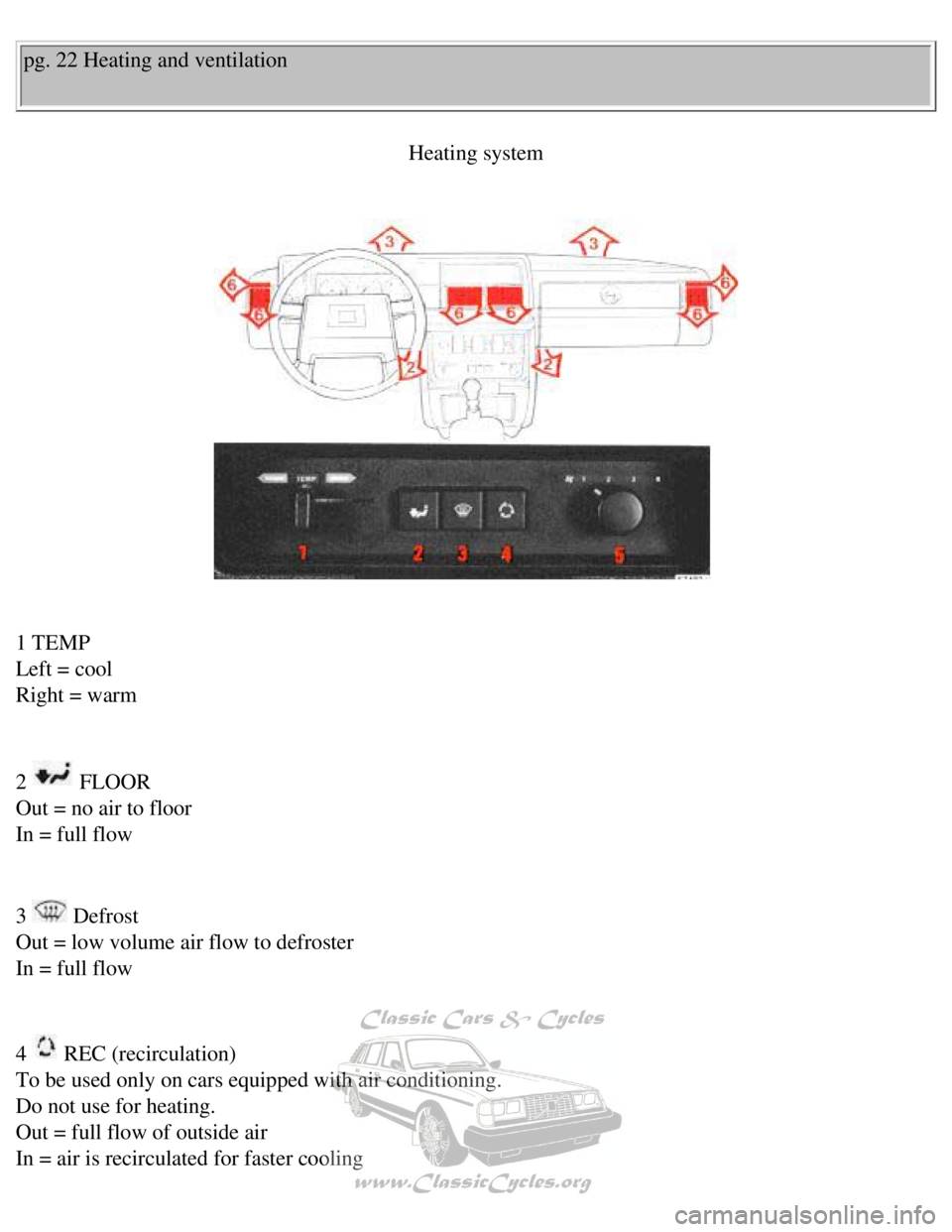
Volvo 1990 240 Model
pg. 22 Heating and ventilation Heating system
1 TEMP
Left = cool
Right = warm
2
FLOOR
Out = no air to floor
In = full flow
3
Defrost
Out = low volume air flow to defroster
In = full flow
4
REC (recirculation)
To be used only on cars equipped with air conditioning.
Do not use for heating.
Out = full flow of outside air
In = air is recirculated for faster cooling
file:///K|/ownersdocs/1990/1990_240/90240_05.htm (1 of 6)12/30/2006 8:\
25:03 AM
Page 27 of 143
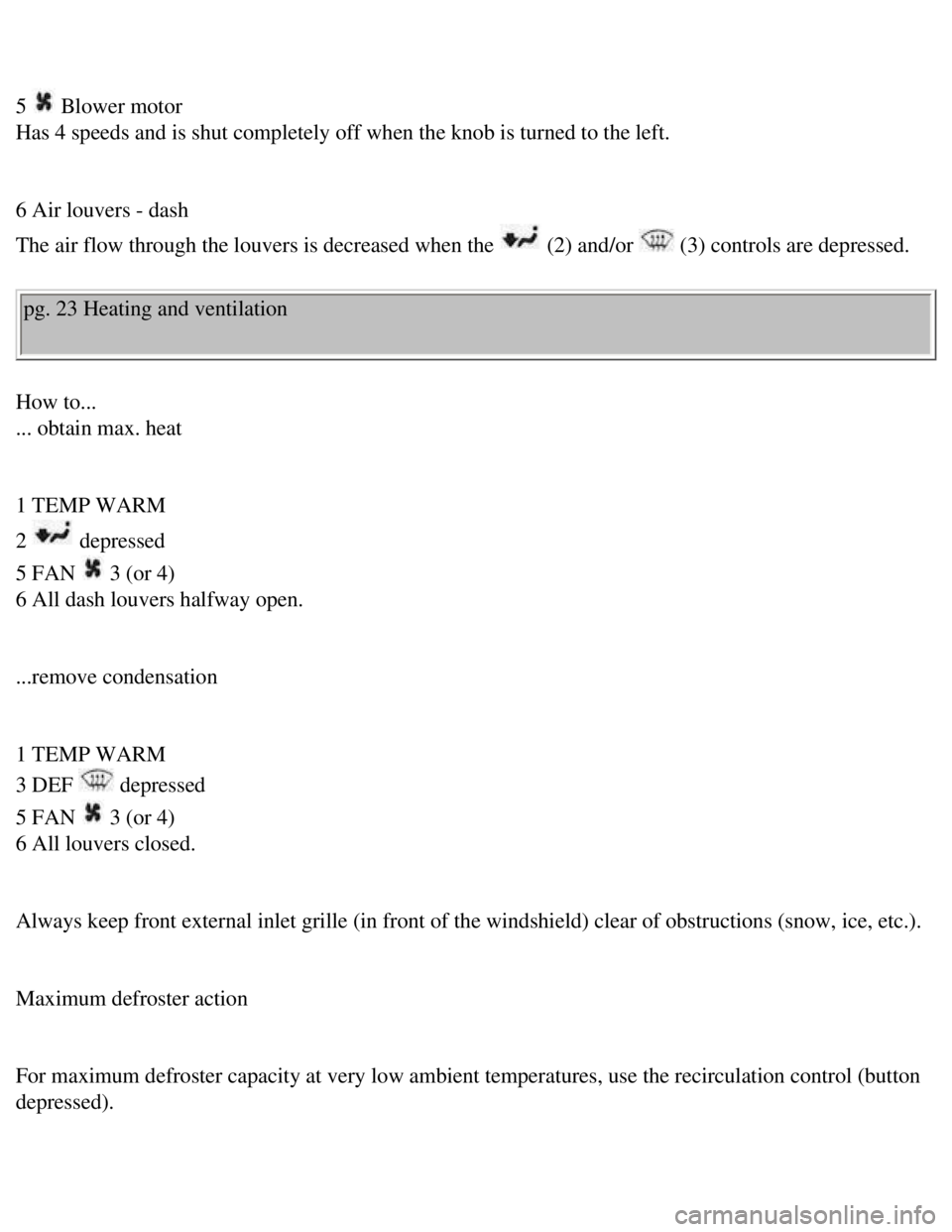
Volvo 1990 240 Model
5
Blower motor
Has 4 speeds and is shut completely off when the knob is turned to the l\
eft.
6 Air louvers - dash
The air flow through the louvers is decreased when the
(2) and/or (3) controls are depressed.
pg. 23 Heating and ventilation
How to...
... obtain max. heat
1 TEMP WARM
2
depressed
5 FAN
3 (or 4)
6 All dash louvers halfway open.
...remove condensation
1 TEMP WARM
3 DEF
depressed
5 FAN
3 (or 4)
6 All louvers closed.
Always keep front external inlet grille (in front of the windshield) c\
lear of obstructions (snow, ice, etc.).
Maximum defroster action
For maximum defroster capacity at very low ambient temperatures, use the\
recirculation control (button
depressed).
file:///K|/ownersdocs/1990/1990_240/90240_05.htm (2 of 6)12/30/2006 8:\
25:03 AM
Page 28 of 143
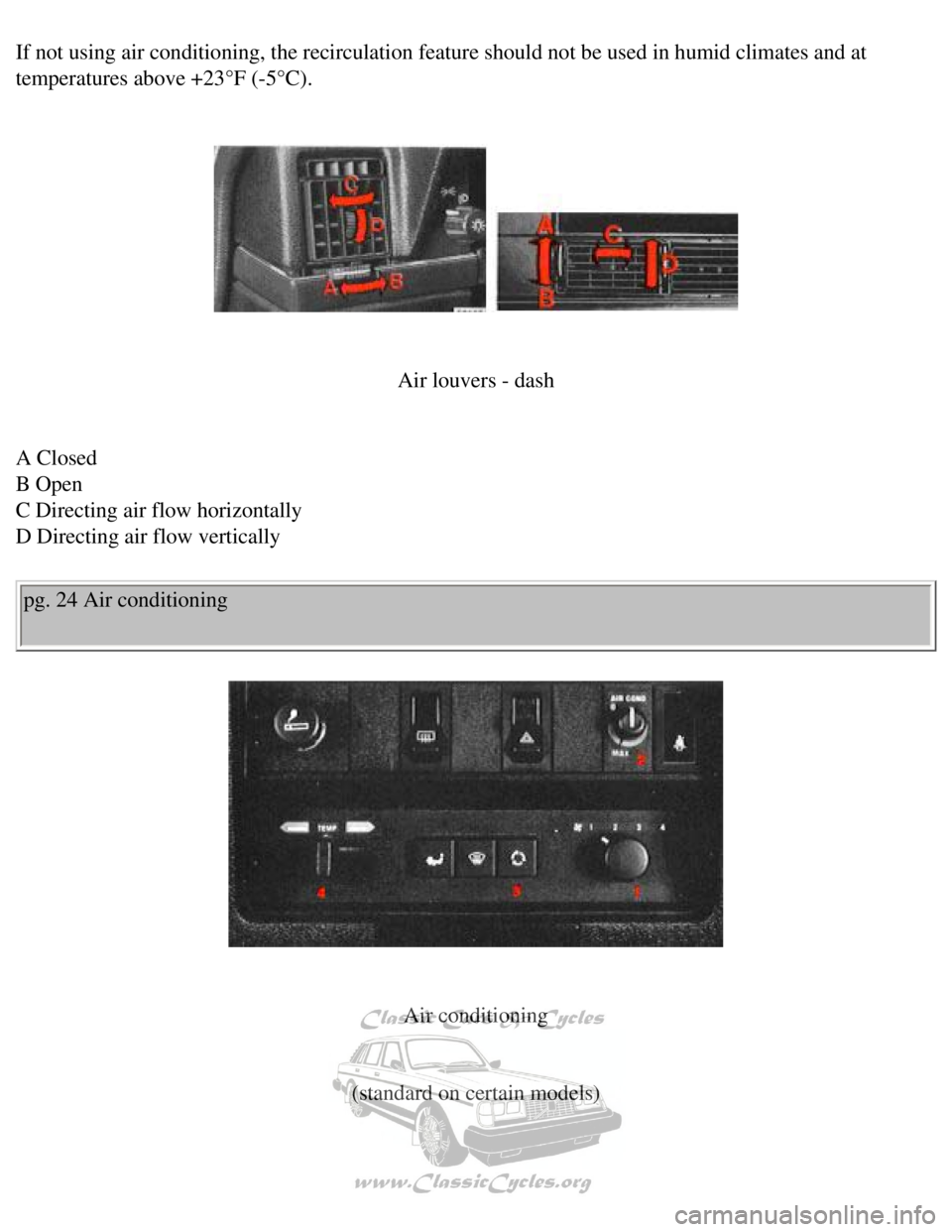
Volvo 1990 240 Model
If not using air conditioning, the recirculation feature should not be u\
sed in humid climates and at
temperatures above +23°F (-5°C).
Air louvers - dash
A Closed
B Open
C Directing air flow horizontally
D Directing air flow vertically
pg. 24 Air conditioning
Air conditioning
(standard on certain models)
file:///K|/ownersdocs/1990/1990_240/90240_05.htm (3 of 6)12/30/2006 8:\
25:03 AM
Page 29 of 143
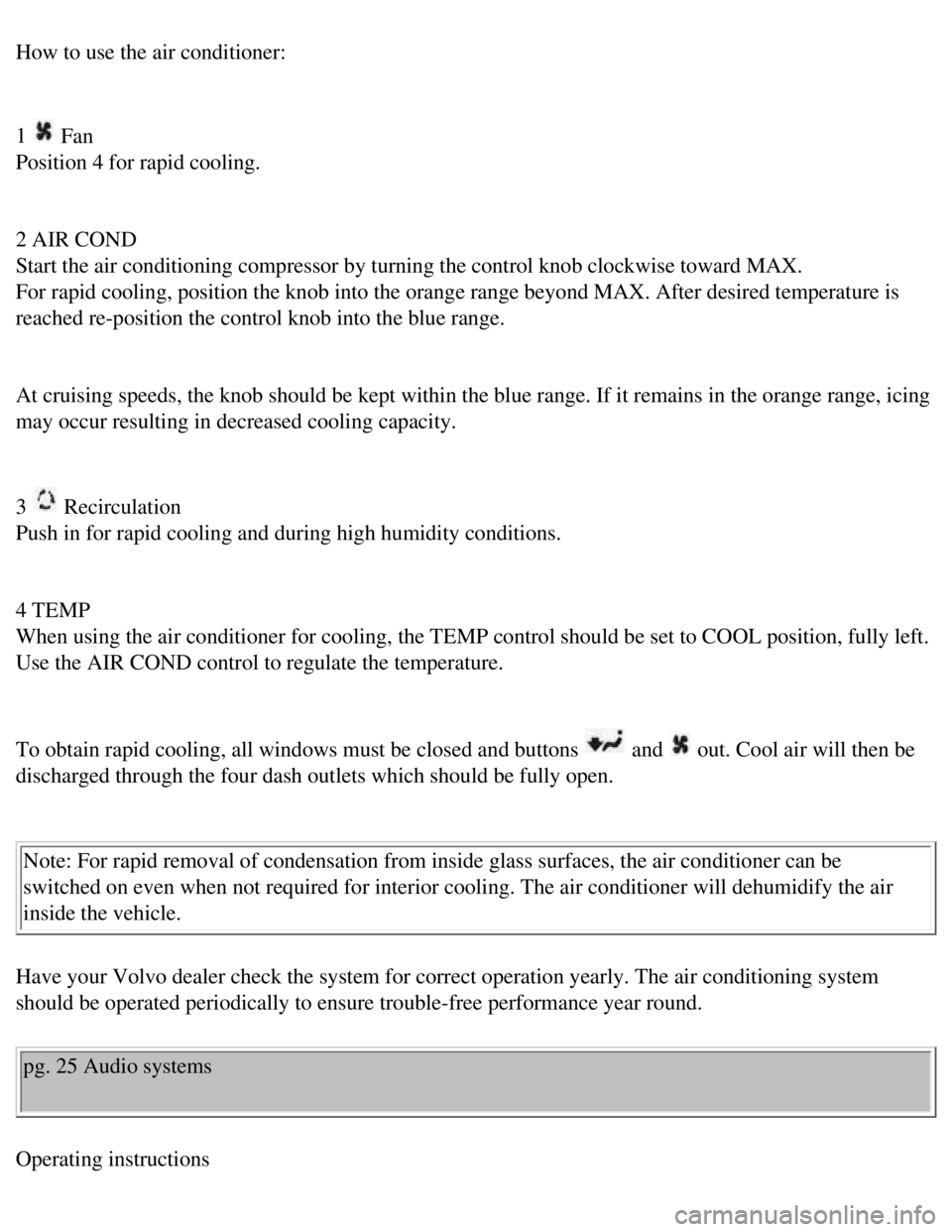
Volvo 1990 240 Model
How to use the air conditioner:
1
Fan
Position 4 for rapid cooling.
2 AIR COND
Start the air conditioning compressor by turning the control knob clockw\
ise toward MAX.
For rapid cooling, position the knob into the orange range beyond MAX. A\
fter desired temperature is
reached re-position the control knob into the blue range.
At cruising speeds, the knob should be kept within the blue range. If it\
remains in the orange range, icing
may occur resulting in decreased cooling capacity.
3
Recirculation
Push in for rapid cooling and during high humidity conditions.
4 TEMP
When using the air conditioner for cooling, the TEMP control should be s\
et to COOL position, fully left.
Use the AIR COND control to regulate the temperature.
To obtain rapid cooling, all windows must be closed and buttons
and out. Cool air will then be
discharged through the four dash outlets which should be fully open.
Note: For rapid removal of condensation from inside glass surfaces, the \
air conditioner can be
switched on even when not required for interior cooling. The air conditi\
oner will dehumidify the air
inside the vehicle.
Have your Volvo dealer check the system for correct operation yearly. Th\
e air conditioning system
should be operated periodically to ensure trouble-free performance year \
round.
pg. 25 Audio systems
Operating instructions
file:///K|/ownersdocs/1990/1990_240/90240_05.htm (4 of 6)12/30/2006 8:\
25:03 AM
Page 30 of 143

Volvo 1990 240 Model
Operating instructions are contained in the manuals associated with each\
model.
These manuals are placed in the cars when the equipment is installed.
Your Volvo Dealer will be able to assist you with any questions regardin\
g the operation of this
equipment.
Radio antenna mast
Note: Always lower the antenna mast when entering automatic car wash. Re\
tractable antennas should
be cleaned and lubricated every 5,000 miles (8,000 km). On fixed (rem\
ovable) mast antennas, be sure
to unscrew and remove the antenna before entering an automatic car wash \
or a garage with low
overhang.
The following information may help to explain differences between car ra\
dio reception and radio
reception in the home.
Signal sending
FM waves do not follow the earth's surface and do not bounce against the\
atmosphere as AM waves do.
Cross modulation
When receiving a weak signal in the vicinity of another, stronger signal\
, both stations may be received
simultaneously.
Weak reception (fading)
Because of the limited range of FM senders and the way FM waves spread, \
this problem usually occurs
with FM reception.
Mountains or similar obstacles can sometimes cause disturbances.
Multipath Distortion
FM Signals are typically "line-of-sight", and very reflective. Their ref\
lectivity to objects such as
buildings, mountains, even other passing vehicles, causes the condition \
known as multipath distortion.
This distortion is the result of the reflected signal, and the direct si\
gnal reaching your antenna at slightly
different times causing a cancellation of all signals. This condition wi\
ll sound like hissing, or static.
Very little can be done to eliminate this problem, however, lowering the\
treble on your radio could help
mask these disturbances thereby allowing you to achieve optimum pleasure\
from your audio system.
file:///K|/ownersdocs/1990/1990_240/90240_05.htm (5 of 6)12/30/2006 8:\
25:03 AM